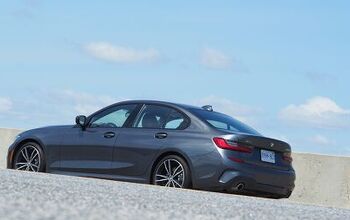2025 BMW 330i xDrive Review: Still The Standard

Five point six seconds. That’s how long it takes the 2025 BMW 330i xDrive to hit 62 mph (100 km/h), officially.
Acceleration is not the point of this car. It is the Default Small Luxury Sport Sedan; it needs to be good at everything. I merely highlight its speedy ways because this is the entry point of 3 Series ownership. For those who aren’t going to stretch to the near-legendary BMW inline-six, does the 330i still deliver the full Bimmer experience?
I spent a week with it to find out.
Quick Take
While the inline-six is still quintessential Bimmer, the four-pot 330i is still an excellent all-rounder and maintains its lead in the segment despite its age.
2025 BMW 330i xDrive: All The Details
What’s New for 2025:
BMW treated the current G20-generation 3 Series to its second facelift this year. Well, sort of. The design is identical to last year’s model, there’s just a pair of new colors (Arctic Race Blue as seen here, and Vegas Red). There are new 19-inch wheel designs too, though as this tester came to us at the height of winter, it ditched those for smaller, basically-black items.
Changes are similarly subtle inside: new materials, new steering wheel designs, and the latest iDrive 8.5 running in the curved dual-screen display.
Now featuring a mild-hybrid assist and the more efficient Miller cycle combustion process, the 330i’s B48 2.0-liter turbo-four pumps out a healthy 255 horsepower and 295 pound-feet of torque. The M340i now also benefits from a mild-hybrid system, providing short bursts of up to 11 hp with a total system peak of 386 hp.
Exterior Style:
The 3 Series is the last of the “old” BMW designs, if there is such a thing. The latest i7 and X3 may be divisive, but they make a statement—and the upcoming Neue Klasse sure should too, based on the shape and detailing alone. This 330i, by comparison, is almost, almost plain. Ubiquity doesn’t detract from the low-key handsomeness nor the classic long-nose, short-tail proportions, even if the current 3 stretches the concept of “compact” to breaking point. The nose is low, and it houses kidneys of acceptable size. There’s a happy simplicity to the taillight design and the gentle curve of a lip connecting them. The exaggerated diffuser design and tall reflectors look fussy, but otherwise, the 3 still looks good.
Powertrain and Fuel Economy:
In a class that features 2.0-liter turbo-fours in practically every single competitor, the 330i’s B48 stands out. Wickedly torquey from barely over idle—295 lb-ft hits at 1,600 pm and hangs around until 4,500 rpm—the engine is also responsive and linear, with no real turbo lag to speak of. The eight-speed auto is as flawless as ever, with smooth shifts and a near-seamless start-stop integration thanks to the mild-hybrid assist. Small paddle shifters give the driver manual control; responses are a little dull even in Sport mode, but feel par for the course at this end of the market. The little engine even sounds pretty good, even if some of that burble is piped in.
BMW has figured out efficiency at a level few other automakers manage. Official figures for the xDrive model come in at 29 mpg combined, split between 26 mpg city and 34 mpg highway. Canadian equivalents are 8.0, 8.9, and 6.9 L/100 km, respectively. American buyers can skip the all-wheel drive and bump the numbers up even further. In practice, during a week of slushy weather and more city mileage than typical, the 330i still came close to its combined rating.
Handling and Drivability:
BMW says it has tweaked the suspension setup for this year’s 3 Series lineup, with that oh-so-common refrain of improving both the handling and the comfort. Since this one also comes with the optional M Sport package, it’s safe to say the balance tips a little towards the former. The pack brings with it a sport suspension and variable-ratio steering, which can add more resistance to the thick steering wheel as the driver ratchets up the drive modes, but does little in terms of the light feedback.
That’s not to say the 330i can’t be fun when desired. BMW’s xDrive stays obviously rear-biased, and the combo of slick roads and reasonably-sized rubber keeps the 3 feeling agile yet in control on some of my favorite back roads. It’s more eager to play than almost any other entry-level competitor but maintains a soft composure throughout the fun.
Ride Quality and Comfort:
Driving this after the too-stiff 550e, I was worried for my teeth. Not a problem. While the M Sport package does put the 330i up on its toes, the ride never falls on the wrong side of firm. Body control is resolute, and like any good German car, it feels utterly tied down on the highway. The standard suspension is probably more than capable enough for most, but those wanting an extra edge won’t mind the bit of stiffness.
BMW’s seats are another strong point. These ones, done up in Cognac faux-leather, are uber comfortable and keep my back ache-free when stuck in the worst of seasonal traffic. While room is aplenty up front, there’s a dearth of legroom out back, especially if the driver or front passenger are lanky.
The 3’s trunk is a capacious 17.0 cubic feet (480 liters), the largest in the segment. Since the Germans are such fans of the superior 40/20/40 split rear bench, the 3 is also just more practical than most competitors, too. I’d still prefer a wagon, though.
Interior Style and Quality:
There are no surprises in the 330i cabin. Every bit of trim feels like it will stay in place longer than any Botox’d celeb’s brows. The architecture is classic BMW, so everything is easy to place, and there’s just enough metallic trim to feel elegant, not shouty. Same with the subdued open-pore wood trim lining the dashboard. BMW’s ambient lighting game is meh—just nine colors!—but hey, if you want the whole steampunk-Vegas shtick, maybe the C-Class is more your speed.
I’ve complained about the overly-thick M steering wheels for years now, so while that still stands here, I do enjoy the architectural trim bits on the six o’clock spoke.
Tech and Safety:
iDrive 8.0 took a critical walloping on release for overcomplicating an otherwise intuitive system. The 8.5 updates found here go a large way towards rectifying this, adding customizable quick-access widgets on the main screen to cut down on menu-diving. Yet as the old saying goes, Herr hat gegeben und der Herr hat genommen: climate controls have all migrated to the bottom of the screen. At least there are still a good amount of controls on the lower dashboard and center console, and the iDrive rotary dial is as easy to use as ever.
Both screens are sharp and easy to read, with quick responses as well. The ubiquitousness of this layout means those graduating to other models in the BMW lineup will find it an easy jump. Wireless Apple CarPlay hooks up quickly and painlessly, and the wireless charger holds phones in place, though they do get quite warm.
BMW still charges for its advanced driver assists when the equivalent is standard on a Toyota Corolla. Mind you, they’re quite good, and the package also includes front cross-traffic alert.
Value Dollars and Sense:
In Canada this tester’s sticker kicks off at $59,380 CAD including destination, and $67,030 CAD with all the options boxes ticked. Yep, cars are pricey, though unless you crave power, I’d say this is a sweet all-rounder.
The different options approaches make a direct US comparison almost impossible. The rear-drive 330i lists for $47,125 including destination; xDrive is another two grand. The closest equivalent build I could muster was around $55,000.
Final Thoughts:
Even seven years into its life, the current BMW 3 Series still impresses. It’s as quick as the six-cylinder models of yesteryear, low-key handsome, and still a bit of fun when the mood hits. For those wanting the classic BMW experience, the 330i delivers.
Become an AutoGuide insider. Get the latest from the automotive world first by subscribing to our newsletter here.
2025 BMW 330i xDrive | |
|---|---|
Powertrain | 8 / 10 |
Efficiency | 9 / 10 |
Handling and Drivability | 8 / 10 |
Passenger Comfort | 8 / 10 |
Ride Quality | 4 / 5 |
Exterior Style | 4 / 5 |
Interior Style and Quality | 8 / 10 |
Infotainment | 8 / 10 |
Cargo Capacity and Towing | 3 / 5 |
Safety | 5 / 5 |
Value | 8 / 10 |
Emotional Appeal | 8 / 10 |
TOTAL | 81 / 100 |
Pros | Cons |
|---|---|
Fun handling balance | Tiny rear seat |
Four-pot is fast | Losing physical controls |
Classic shape/looks | Steering lacks feedback |
Engine/Motor: | 2.0L I4 Turbo |
Output: | 255 hp, 295 lb-ft |
Drivetrain: | AWD |
Transmission: | 8AT |
US Fuel Economy (mpg): | 26/34/29 |
CAN Fuel Economy (L/100 km): | 8.9/6.9/8.0 |
Starting Price (USD): | $49,125 (inc. dest.) |
As-Tested Price (USD): | See text |
Starting Price (CAD): | $59,380 (inc. dest.) |
As-Tested Price (CAD): | $67,030 (inc. dest.) |

Kyle began his automotive obsession before he even started school, courtesy of a remote control Porsche and various LEGO sets. He later studied advertising and graphic design at Humber College, which led him to writing about cars (both real and digital). He is now a proud member of the Automobile Journalists Association of Canada (AJAC), where he was the Journalist of the Year runner-up for 2021.
More by Kyle Patrick









































Comments
Join the conversation